The Gaumont British Picture Corporation (GB) was a company that produced and distributed films and operated a cinema chain in the United Kingdom. In the 1930s, it was the largest film company in the UK, employing 16,000 people. Among the studio's best known films are two of Alfred Hitchcock's classic British thrillers, The 39 Steps (1935) and The Lady Vanishes (1938). Major stars of the studio were Jessie Matthews, Robert Donat, Madeleine Carroll, Conrad Veidt, Jack Hulbert, Cicely Courtneidge, Gordon Harker, and many others. Gaumont and its subsidiary Gainsborough produced 721 films.
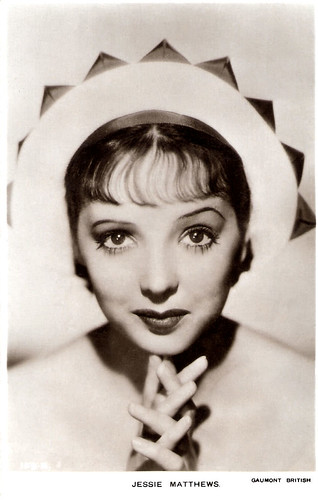
British postcard, no. 159b. Photo: Gaumont-British.
Saucer-eyed, long-legged Jessie Matthews (1907-1981) was a gamine, graceful dancer, with a sweet, pure-toned singing voice, and waif-like sex appeal, who embodied 1930s style. For most of the decade, she was the most popular musical star in England.
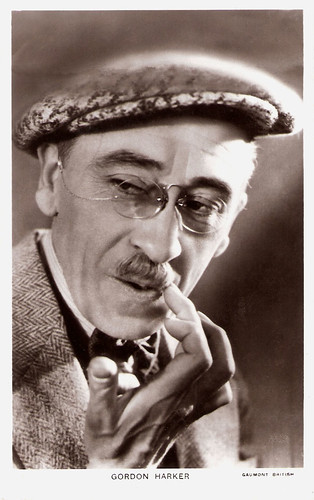
British postcard in the Picturegoer Series, no. 717. Photo: Gaumont-British.
Gordon Harker (1885-1967) was a popular English film actor who specialised in Cockney roles. Throughout the 1930s and 1940s, he seemed to appear in every crime film produced in England, including four directed by Alfred Hitchcock.

British postcard by Raphael Tuck & Sons, no. 14. Photo: Gaumont-British.
Cicely Courtneidge (1893–1980) was an elegantly knockabout comedienne. For 62 years, she formed a husband and wife team with comedian Jack Hulbert on stage, radio, TV and in the cinema. During the 1930s she also starred in eleven British films and one disastrous American production.
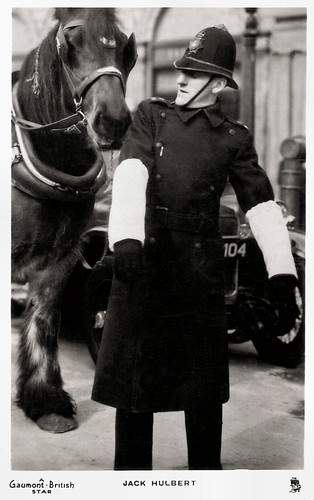
British postcard by Raphael Tuck & Sons 'Real Photograph', no. 15. Photo: Gaumont-British.
Jack Hulbert (1892-1978) was a popular comedian of the 1930s with a trademark chiseled chin. In his musicals he often appeared with his wife Cicely Courtneidge.

British postcard by Raphael Tuck & Sons in the Real Photograph Series, no. 7-8. Photo: Gaumont-British.
Madeleine Carroll (1906–1987) was a blonde beauty of ladylike demeanour. The first of Alfred Hitchcock's ‘ice-cool blondes’ was immensely popular in the 1930s and 1940s, and was nicknamed 'The Queen of British Cinema'.
Gaumont-British was founded by Frenchman Leon Gaumont in 1898 as the British subsidiary of the French Gaumont Film Company. The first studio was established at Freeman's Cricket Field in Dulwich. The first director was Alfred Collins. Many successful films, like A Runaway Match (Alfred Collins, 1903), Lost! A Leg of Mutton (Alfred Collins, 1906), Curfew Shall Not Ring To-night (Arthur Gilbert, 1907), and Napoleon and the English Sailor (Alfred Collins, 1908) with Herbert Darnley, were made at Dulwich, and England was at the time the chief supplier of films for the American market.
Gaumont invented the Chronophone and the Chronochrome. The Chronophone involved a synchronised gramophone disc sounding together with the silent picture, to produce a talking picture as early as 1902. The Chronochrome, introduced in 1913, was an equally successful attempt at reproduction in natural colours by the simultaneous projection of three pictures through a coloured screen in green, red and purple violet.
Gaumont recorded several important topical events. Gaumont decided that production must be undertaken on a far larger scale in England than ever before. More extensive studios were necessary, and the first British building solely for the purpose of film production was erected with the most modern equipment and laboratories on the same site at Lime Grove in Shepherd's Bush. The first automatic film printing works set up at Lime Grove for world-wide trade in 1912.
In 1913 Gaumont distributed the first feature length film in England. It was the Messter Film production Richard Wagner/The Life of Richard Wagner (Carl Froelich, William Wauer, 1913), with an elaborate musical setting provided by the London Symphony Orchestra under the direction of Sir Landon Ronald.
George Pearson directed for Gaumont-British the four part serial Ultus, the Man from the Dead (George Pearson, 1915) starring Aurele Sydney a.k.a. Aurelio Sidney. The film was so successful that a series of Ultus pictures was made. This series was followed by Sally Bishop (George Pearson, 1916) with Marjorie Villis, Aurele Sydney and Peggy Hyland.
During the First World War, the British Government took over the building and the studio was used for research and propaganda purposes, although film production was permitted to continue part-time. Thus the Shepherd's Bush Studios not only assisted in the propagation of the war, but also provided entertainment for a war-weary public such as a film version of H. G. Wells's The First Men in the Moon (Bruce Gordon, J.L.V. Leigh, 1919).
After the war, the British industry appeared completely crushed.

British postcard in the Picturegoer Series, no. 1193. Photo: Gaumont-British.
Derrick De Marney (1906–1978) was a handsome and versatile English stage and film actor. Today, he is best known for his starring role as Robert Tisdall, wrongly accused of murder in Alfred Hitchcock's Young and Innocent (1937).

British postcard, no. 162 A. Photo: Gaumont-British.
As a teenager Nova Pilbeam played in two Alfred Hitchcock classics, The Man Who Knew Too Much (1934) and Young and Innocent (1937). In 1948 she vanished from the British cinema.

British postcard in the Picturegoer Series, London, no. 1033. Photo: Gaumont-British.
Peter Lorre (1904–1964) with his trademark large, popped eyes, his toothy grin and his raspy voice was an American actor of Jewish Austro-Hungarian descent. He was an international sensation as the psychopathic child murderer in Fritz Lang’s M (1931). He later became a popular actor in a two British Hitchcock films and in a series of Hollywood crime films and mysteries.
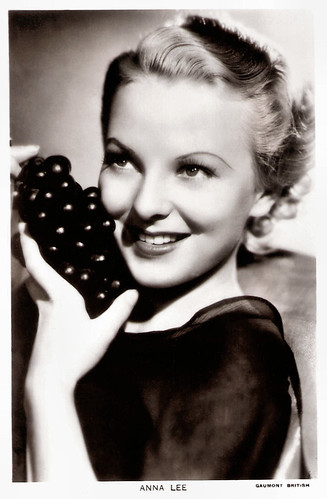
British postcard in the Picturegoer Series, London, no. 880b. Photo: Gaumont-British.
Blue-eyed blonde Anna Lee (1913-2004) was a British-born American actress. She started her career in British films and earned the title 'Queen of the Quota Quickies'. In 1939, she moved to Hollywood with her husband, director Robert Stevenson.

British postcard by Raphael Tuck & Sons in the Real Photograph Series, no. 176. Photo: Gaumont-British.
Herbert Marshall (1890-1966), was a popular English cinema and theatre actor. He overcame the loss of a leg in World War I to enjoy a long career in Hollywood, first as a romantic lead opposite stars like Marlene Dietrich and Greta Garbo, later as a fine character actor.
The British subsidiary of Gaumont became independent in 1922 when Leon Gaumont sold the control of the company to Isidore Ostrer. Born in 1889 to a humble Jewish family in Whitechapel, Ostrer had made his first fortune in textiles during World War 1, then he established a private bank, and in 1922 he took over the Gaumont film company and renamed it Gaumont-British.
Ostrer engaged his four brothers to run the company with him. He made his brother Maurice Ostrer director of both the corporation and the sister company Gainsborough studios, where Maurice acted in the capacity of executive film producer. Brother Mark Ostrer was the chairman, who oversaw the 343 cinemas, theatres, dance halls, and restaurants owned, controlled or managed by the corporation and associated companies.
Fourth brother, Harry Ostrer, who had been a school teacher, worked with scripts. His daughter became 'the Gainsborough lady', who nodded her head at the beginning of each film. The fifth brother, David Ostrer, worked in distribution. Years later, his son, Bertram Ostrer, produced a few films independently, including Dentist in the Chair (Don Chaffey, 1960) starring Bob Monkhouse, Dentist on the Job (C.M. Pennington-Richards, 1961), and Captain Nemo and the Underwater City (James Hill, 1969) with Robert Ryan.
The first film under the Gainsborough banner was released in 1924. Four years later, Gainsborough Pictures Limited was established as one of the associated production companies within the Gaumont-British Picture Corporation Limited. During this period films were produced under both banners, Gaumont and Gainsborough. The Gaumont banner was dropped in 1938, and all films produced from 1938 to 1950 were under the Gainsborough banner. (Next week, EFSP will do a post on Gainsborough).
In 1927 a leading silent film studio, the Ideal Film Company, merged with Gaumont. After a few years, sound film arrived. The film industry was immensely boosted by the arrival of talkies in 1929, and cinema attendance also rose because of audiences' need for mental escape from the bad economic times and the growing troubles in Europe.
Maurice Elvey was directing High Treason (Maurice Elvey, 1929) with Benita Hume and Basil Gill. when sound film arrived and the film had to be turned into a 'talkie' under difficult conditions. Sound-proofing had to be done while the film was actually being made.
In the summer of 1931, during Victor Saville's direction of the sound film version of Hindle Wakes (Victor Saville, 1931) with Sybil Thorndike and John Stuart, the new condenser microphone of British Acoustic was first used. Since that date all Gaumont-British productions used this apparatus.

British postcard issued with Sarony Cigarettes, no. 67 of a second series of 42 Cinema Stars. Photo: Gaumont. Publicity still for High Treason (Maurice Elvey, 1929) with Basil Gill.
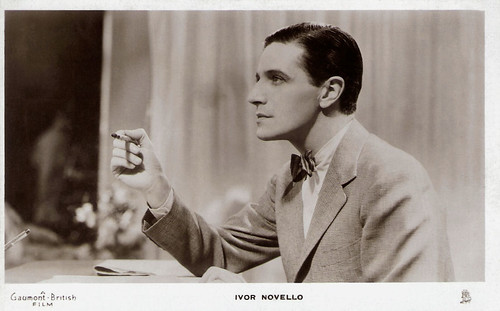
British postcard by Raphael Tuck & Sons, London, no. 50-S. Photo: Gaumont-British. Ivor Novello in Love and Let Love/Sleeping Car (Anatole Litvak, 1933).
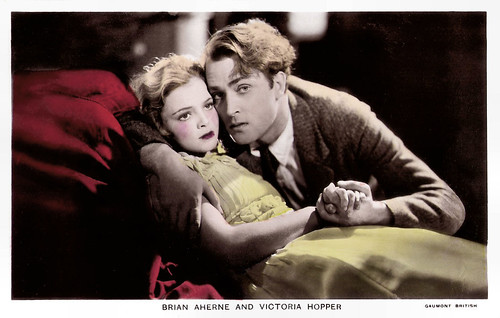
British Real Photograph postcard in the Film Partners series, no. P 121. Photo: Gaumont-British. Brian Aherne and Victoria Hopper in The Constant Nymph (Basil Dean, 1933).
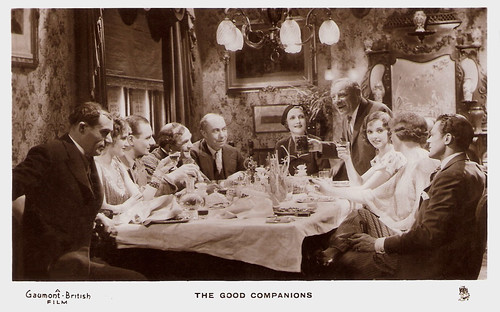
British postcard by Raphael Tuck & Sons in the Real Photograph Series, no. 27-B. Photo: Gaumont-British. Publicity still for The Good Companions (Victor Saville, 1933) with a.o. John Gielgud (third from left), A.W. Baskcomb (fifth from left) and Jessie Matthews (third from right).

British hand-coloured postcard in the Film Partners Series, no PC 236. Photo: Gaumont-British. Derrick De Marney and Nova Pilbeam in Young and Innocent/The Girl Was Young (Alfred Hitchcock, 1937).

British postcard by Raphael Tuck & Sons (Real Photograph), no. 166. Photo: Gaumont-British.
Tall and good-looking Matheson Lang (1879-1948) was a Canadian-born stage and film actor and playwright. He is best known for his Shakespearean roles in British productions of Hamlet, Macbeth, and Romeo and Juliet and for his role as Mr. Wu in the early 20th century. He was one of the first major stars of the British theatre who acted in a silent film. During the 1920s, he became a popular film star in Great Britain.
Gaumont-British (GB) moved into its decade of glory, the 1930s. GB dominated the British film industry with its large chain of cinemas and its vast studio complex at Lime Grove. The company employed 16,000 people. Amongst the directors were Victor Saville, Walter Forde, William Thiele, Anthony Asquith, Sinclair Hill, and Alfred Hitchcock. Several other internationally known names were added later.
Alfred Hitchcock directed eleven films for Gaumont and Gainsborough. Before his directing debut, he adapted the screenplays for three Gainsborough films in 1924 and 1925. He then directed five Gainsborough films in 1926 and 1927. After a six year absence, he directed five Gaumont films between 1934 and 1937, including his adaptation of The 39 Steps (Alfred Hitchcock, 1935), starring Robert Donat and Madeleine Carroll. In 1938, Hitchcock directed one more Gainsborough film, The Lady Vanishes (Alfred Hitchcock, 1938) with Margaret Lockwood and Michael Redgrave.
The list of actors and actresses on contract by GB in were of equal distinction, including Jack Hulbert, Cicely Courtneidge, Gordon Harker, John Stuart, Belle Chrystall, Renate Müller, Fred Kerr, Sonnie Hale, and Edmund Gwenn.
Early in 1932, GB quietly took over Baird Television Ltd. which had become financially precarious. As a result, Baird Television received a badly-needed infusion of capital which enabled it to hire scientists with expertise in the new technology of electronic television, and to move to the Crystal Palace where a fully equipped television studio and ultra short wave transmitter was set up.
After a boardroom coup in 1933, Nigel Ostrer's position as managing director became nominal. Under the new arrangement he did research on large-screen and colour television. The Ostrers felt that television could be part of his film empire, with live telecasts of sporting events being shown on cinema screens as an accompaniment to the main feature film.
In the United States, Gaumont-British had its own distribution operation for its films until December 1938, when it outsourced distribution to 20th Century Fox.
At the outbreak of the Second World War, all television was shut down. GB came under scrutiny by a Board of Trade enquiry and Ostrer also felt threatened by the possibility of German invasion. In 1940 he was named on the infamous Nazi death list of people they thought to be a danger, including Winston Churchill, J.B. Priestly and Noel Coward.
In 1941, rival film magnate J. Arthur Rank of the Rank Organisation bought Gaumont-British and its sister company Gainsborough Pictures. Isidore Ostrer moved to the USA for the war years and though he eventually returned to Britain he never made a major comeback in the film industry. His business interest returned to the textile industry in which he had started many years earlier. He lived on until 1975 in semi-seclusion.
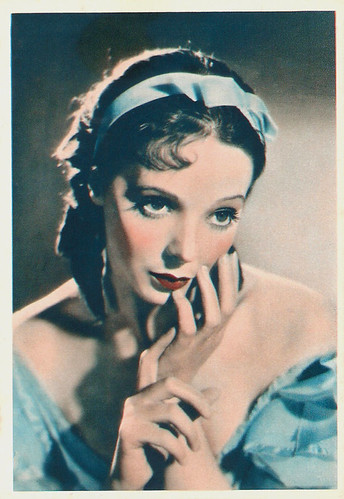
British collectors card by De Reszke Cigarettes, no. 9. Photo: Gaumont-British. Jessie Matthews in Waltzes from Vienna (Alfred Hitchcock, 1934).
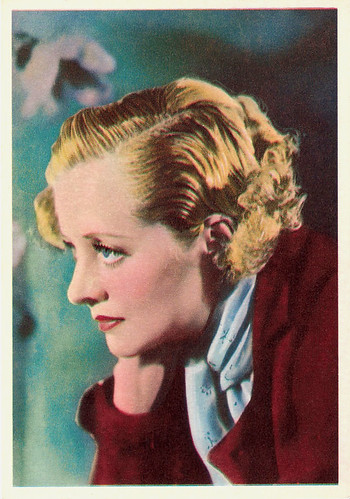
British postcard by De Reszke Cigarettes, no. 21. Photo: Gaumont-British.
Evelyn Laye (1900–1996) was one of England's most popular stars of musical revue and operetta during the 1920s. She did a few screen appearances in both London and Hollywood, including in the classic musical Evensong (Victor Saville, 1934).

British postcard by De Reszke Cigarettes, no. 32. Photo: Gaumont-British. Madeleine Carroll in The Dictator/Loves of a Dictator (Victor Saville, 1935).

British postcard by De Reszke Cigarettes, no. 33. Photo: Gaumont-British. Conrad Veidt in Jew Süss (Lothar Mendes, 1934).
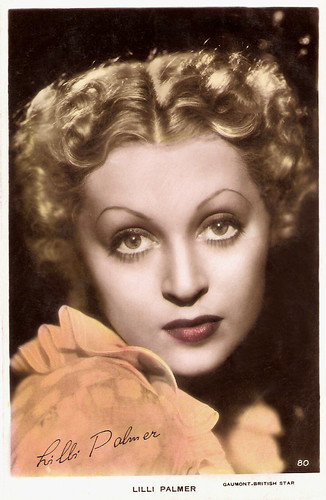
British postcard by Art Card, no. 80. Photo: Gaumont-British. This card dates from the years Lilli Palmer played in Alfred Hitchcock's Secret Agent (1936).
Gaumont-British developed or acquired large 'super-cinemas' such as the New Victoria (later Gaumont and finally Odeon) in Bradford opened in 1930, the Gaumont in Manchester opened in 1935, and the Gaumont State Cinema in Kilburn, London, opened in 1937.
The corporation also took over many smaller cinemas across the country, eventually owning 343 properties. One such property was the Holderness Hall in Hull, built by the pioneering William Morton in 1912 and managed by him until 1930 when he could no longer compete.
Many of the Gaumont cinemas had a theatre organ for entertainment before the show, in the intervals, or after the show. The name 'Gaumont' was adopted to describe the style of the flat-top organ console case (originally for the Pavilion Theatre, Shepherd's Bush), for some Compton organs built from October 1931 to 1934.
In 1941, after the take-over by Rank, all Gaumont cinemas were rebranded as Odeon cinemas. Cinema exhibition in the UK was characterised by alignments between exhibitors and distributors. After the Odeon and Gaumont takeovers, Rank had access to the product of 20th Century Fox, Paramount, Disney, Columbia, Universal, United Artists and its own film productions. Rival ABC had only Warner Brothers, MGM and its own ABPC productions but both also took films from smaller distributors.
With ample supply of product, Rank maintained the separate Odeon and Gaumont release pattern for many years. Some Odeon cinemas were renamed Gaumont when transferred to Gaumont release. As attendances declined during the 1950s many cinemas on all circuits were closed and eventually, the booking power of the Gaumont circuit declined. In January 1959 Rank restructured its exhibition operation and combined the best Gaumonts and the best Odeons in a new Rank release, while the rest were given a new 'National' release.
In 1961, Paramount objected to Rank consigning its Dean Martin comedy All in a Night's Work (Joseph Anthony, 1961) to the national circuit and henceforth switched its allegiance to the ABC circuit. With the continuing decline in attendances and cinema numbers, the National release died on its feet and henceforth there were two release patterns, Rank and ABC.
There was no reason to perpetuate the Gaumont name and in towns that lost their Odeon, the Gaumont was usually renamed Odeon within a couple of years of the latter's closure. Even so, the Gaumont name continued to linger until, in January 1987, the last Gaumont, in Doncaster, was renamed Odeon.

British postcard by Raphael Tuck & Sons' Real Photograph, no. 42-S. Photo: Gaumont-British.
A.W. Baskcomb (1880-1939) is best remembered for his creation of the part of ‘Slightly’ in the very first stage production of J.M. Barrie's Peter Pan (1904). He created a major character out of an underwritten part and went on to play it for seven years. At the end of his career he became briefly a popular film star.
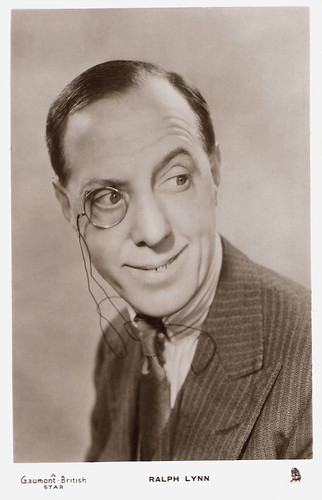
British postcard by Raphael Tuck & Sons' Real Photograph, London, no. 30-S. Photo: Gaumont-British.
British actor Ralph Lynn (1882-1962) was a tweedy, dark-haired comedian who made a stage career out of playing monocled silly ass twits. He was a veteran performer of London's highly popular Aldwych Repertory Theatre farces, and he and fellow members Tom Walls and Robertson Hare successfully took many of their stylised productions to the big screen in the 1930s.

British postcard by Raphael Tuck & Sons, Real Photograph Postcard, no. 178. Photo: Gaumont-British.
English actor Tom Walls (1883-1949) was a popular character player on stage and in films, and also worked as a film director. He is indelibly associated with the popular Aldwych Theatre farces of the 1920s and 1930s and was one of the most influential figures in British comedy.

British postcard in the Picturegoer Series, no. 947a. Photo: Gaumont-British.
Robertson Hare (1891-1979) was an English actor, who came to fame in the Aldwych farces between 1923 and 1933. Bald, short and fussy, Hare made his career in character roles, often as a figure of put-upon respectability.
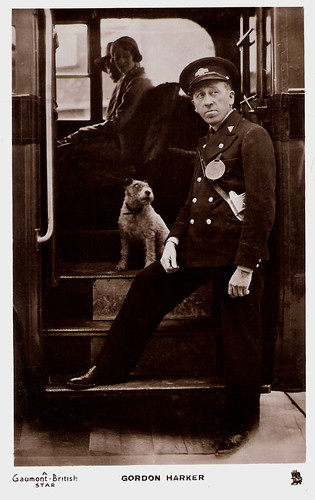
British Real Photograph postcard by Raphael Tuck & Sons, no. 19-S. Photo: Gaumont-British. Gordon Harker in Love On Wheels (Victor Saville, 1932).
Sources: Nigel Ostrer (The Ostrers and Gaumont British), Wikipedia and IMDb.

British postcard, no. 159b. Photo: Gaumont-British.
Saucer-eyed, long-legged Jessie Matthews (1907-1981) was a gamine, graceful dancer, with a sweet, pure-toned singing voice, and waif-like sex appeal, who embodied 1930s style. For most of the decade, she was the most popular musical star in England.

British postcard in the Picturegoer Series, no. 717. Photo: Gaumont-British.
Gordon Harker (1885-1967) was a popular English film actor who specialised in Cockney roles. Throughout the 1930s and 1940s, he seemed to appear in every crime film produced in England, including four directed by Alfred Hitchcock.

British postcard by Raphael Tuck & Sons, no. 14. Photo: Gaumont-British.
Cicely Courtneidge (1893–1980) was an elegantly knockabout comedienne. For 62 years, she formed a husband and wife team with comedian Jack Hulbert on stage, radio, TV and in the cinema. During the 1930s she also starred in eleven British films and one disastrous American production.

British postcard by Raphael Tuck & Sons 'Real Photograph', no. 15. Photo: Gaumont-British.
Jack Hulbert (1892-1978) was a popular comedian of the 1930s with a trademark chiseled chin. In his musicals he often appeared with his wife Cicely Courtneidge.

British postcard by Raphael Tuck & Sons in the Real Photograph Series, no. 7-8. Photo: Gaumont-British.
Madeleine Carroll (1906–1987) was a blonde beauty of ladylike demeanour. The first of Alfred Hitchcock's ‘ice-cool blondes’ was immensely popular in the 1930s and 1940s, and was nicknamed 'The Queen of British Cinema'.
Gaumont Film production
Gaumont-British was founded by Frenchman Leon Gaumont in 1898 as the British subsidiary of the French Gaumont Film Company. The first studio was established at Freeman's Cricket Field in Dulwich. The first director was Alfred Collins. Many successful films, like A Runaway Match (Alfred Collins, 1903), Lost! A Leg of Mutton (Alfred Collins, 1906), Curfew Shall Not Ring To-night (Arthur Gilbert, 1907), and Napoleon and the English Sailor (Alfred Collins, 1908) with Herbert Darnley, were made at Dulwich, and England was at the time the chief supplier of films for the American market.
Gaumont invented the Chronophone and the Chronochrome. The Chronophone involved a synchronised gramophone disc sounding together with the silent picture, to produce a talking picture as early as 1902. The Chronochrome, introduced in 1913, was an equally successful attempt at reproduction in natural colours by the simultaneous projection of three pictures through a coloured screen in green, red and purple violet.
Gaumont recorded several important topical events. Gaumont decided that production must be undertaken on a far larger scale in England than ever before. More extensive studios were necessary, and the first British building solely for the purpose of film production was erected with the most modern equipment and laboratories on the same site at Lime Grove in Shepherd's Bush. The first automatic film printing works set up at Lime Grove for world-wide trade in 1912.
In 1913 Gaumont distributed the first feature length film in England. It was the Messter Film production Richard Wagner/The Life of Richard Wagner (Carl Froelich, William Wauer, 1913), with an elaborate musical setting provided by the London Symphony Orchestra under the direction of Sir Landon Ronald.
George Pearson directed for Gaumont-British the four part serial Ultus, the Man from the Dead (George Pearson, 1915) starring Aurele Sydney a.k.a. Aurelio Sidney. The film was so successful that a series of Ultus pictures was made. This series was followed by Sally Bishop (George Pearson, 1916) with Marjorie Villis, Aurele Sydney and Peggy Hyland.
During the First World War, the British Government took over the building and the studio was used for research and propaganda purposes, although film production was permitted to continue part-time. Thus the Shepherd's Bush Studios not only assisted in the propagation of the war, but also provided entertainment for a war-weary public such as a film version of H. G. Wells's The First Men in the Moon (Bruce Gordon, J.L.V. Leigh, 1919).
After the war, the British industry appeared completely crushed.

British postcard in the Picturegoer Series, no. 1193. Photo: Gaumont-British.
Derrick De Marney (1906–1978) was a handsome and versatile English stage and film actor. Today, he is best known for his starring role as Robert Tisdall, wrongly accused of murder in Alfred Hitchcock's Young and Innocent (1937).

British postcard, no. 162 A. Photo: Gaumont-British.
As a teenager Nova Pilbeam played in two Alfred Hitchcock classics, The Man Who Knew Too Much (1934) and Young and Innocent (1937). In 1948 she vanished from the British cinema.

British postcard in the Picturegoer Series, London, no. 1033. Photo: Gaumont-British.
Peter Lorre (1904–1964) with his trademark large, popped eyes, his toothy grin and his raspy voice was an American actor of Jewish Austro-Hungarian descent. He was an international sensation as the psychopathic child murderer in Fritz Lang’s M (1931). He later became a popular actor in a two British Hitchcock films and in a series of Hollywood crime films and mysteries.

British postcard in the Picturegoer Series, London, no. 880b. Photo: Gaumont-British.
Blue-eyed blonde Anna Lee (1913-2004) was a British-born American actress. She started her career in British films and earned the title 'Queen of the Quota Quickies'. In 1939, she moved to Hollywood with her husband, director Robert Stevenson.

British postcard by Raphael Tuck & Sons in the Real Photograph Series, no. 176. Photo: Gaumont-British.
Herbert Marshall (1890-1966), was a popular English cinema and theatre actor. He overcame the loss of a leg in World War I to enjoy a long career in Hollywood, first as a romantic lead opposite stars like Marlene Dietrich and Greta Garbo, later as a fine character actor.
Gainsborough and Gaumont
The British subsidiary of Gaumont became independent in 1922 when Leon Gaumont sold the control of the company to Isidore Ostrer. Born in 1889 to a humble Jewish family in Whitechapel, Ostrer had made his first fortune in textiles during World War 1, then he established a private bank, and in 1922 he took over the Gaumont film company and renamed it Gaumont-British.
Ostrer engaged his four brothers to run the company with him. He made his brother Maurice Ostrer director of both the corporation and the sister company Gainsborough studios, where Maurice acted in the capacity of executive film producer. Brother Mark Ostrer was the chairman, who oversaw the 343 cinemas, theatres, dance halls, and restaurants owned, controlled or managed by the corporation and associated companies.
Fourth brother, Harry Ostrer, who had been a school teacher, worked with scripts. His daughter became 'the Gainsborough lady', who nodded her head at the beginning of each film. The fifth brother, David Ostrer, worked in distribution. Years later, his son, Bertram Ostrer, produced a few films independently, including Dentist in the Chair (Don Chaffey, 1960) starring Bob Monkhouse, Dentist on the Job (C.M. Pennington-Richards, 1961), and Captain Nemo and the Underwater City (James Hill, 1969) with Robert Ryan.
The first film under the Gainsborough banner was released in 1924. Four years later, Gainsborough Pictures Limited was established as one of the associated production companies within the Gaumont-British Picture Corporation Limited. During this period films were produced under both banners, Gaumont and Gainsborough. The Gaumont banner was dropped in 1938, and all films produced from 1938 to 1950 were under the Gainsborough banner. (Next week, EFSP will do a post on Gainsborough).
In 1927 a leading silent film studio, the Ideal Film Company, merged with Gaumont. After a few years, sound film arrived. The film industry was immensely boosted by the arrival of talkies in 1929, and cinema attendance also rose because of audiences' need for mental escape from the bad economic times and the growing troubles in Europe.
Maurice Elvey was directing High Treason (Maurice Elvey, 1929) with Benita Hume and Basil Gill. when sound film arrived and the film had to be turned into a 'talkie' under difficult conditions. Sound-proofing had to be done while the film was actually being made.
In the summer of 1931, during Victor Saville's direction of the sound film version of Hindle Wakes (Victor Saville, 1931) with Sybil Thorndike and John Stuart, the new condenser microphone of British Acoustic was first used. Since that date all Gaumont-British productions used this apparatus.

British postcard issued with Sarony Cigarettes, no. 67 of a second series of 42 Cinema Stars. Photo: Gaumont. Publicity still for High Treason (Maurice Elvey, 1929) with Basil Gill.

British postcard by Raphael Tuck & Sons, London, no. 50-S. Photo: Gaumont-British. Ivor Novello in Love and Let Love/Sleeping Car (Anatole Litvak, 1933).

British Real Photograph postcard in the Film Partners series, no. P 121. Photo: Gaumont-British. Brian Aherne and Victoria Hopper in The Constant Nymph (Basil Dean, 1933).

British postcard by Raphael Tuck & Sons in the Real Photograph Series, no. 27-B. Photo: Gaumont-British. Publicity still for The Good Companions (Victor Saville, 1933) with a.o. John Gielgud (third from left), A.W. Baskcomb (fifth from left) and Jessie Matthews (third from right).

British hand-coloured postcard in the Film Partners Series, no PC 236. Photo: Gaumont-British. Derrick De Marney and Nova Pilbeam in Young and Innocent/The Girl Was Young (Alfred Hitchcock, 1937).

British postcard by Raphael Tuck & Sons (Real Photograph), no. 166. Photo: Gaumont-British.
Tall and good-looking Matheson Lang (1879-1948) was a Canadian-born stage and film actor and playwright. He is best known for his Shakespearean roles in British productions of Hamlet, Macbeth, and Romeo and Juliet and for his role as Mr. Wu in the early 20th century. He was one of the first major stars of the British theatre who acted in a silent film. During the 1920s, he became a popular film star in Great Britain.
Gaumont British
Gaumont-British (GB) moved into its decade of glory, the 1930s. GB dominated the British film industry with its large chain of cinemas and its vast studio complex at Lime Grove. The company employed 16,000 people. Amongst the directors were Victor Saville, Walter Forde, William Thiele, Anthony Asquith, Sinclair Hill, and Alfred Hitchcock. Several other internationally known names were added later.
Alfred Hitchcock directed eleven films for Gaumont and Gainsborough. Before his directing debut, he adapted the screenplays for three Gainsborough films in 1924 and 1925. He then directed five Gainsborough films in 1926 and 1927. After a six year absence, he directed five Gaumont films between 1934 and 1937, including his adaptation of The 39 Steps (Alfred Hitchcock, 1935), starring Robert Donat and Madeleine Carroll. In 1938, Hitchcock directed one more Gainsborough film, The Lady Vanishes (Alfred Hitchcock, 1938) with Margaret Lockwood and Michael Redgrave.
The list of actors and actresses on contract by GB in were of equal distinction, including Jack Hulbert, Cicely Courtneidge, Gordon Harker, John Stuart, Belle Chrystall, Renate Müller, Fred Kerr, Sonnie Hale, and Edmund Gwenn.
Early in 1932, GB quietly took over Baird Television Ltd. which had become financially precarious. As a result, Baird Television received a badly-needed infusion of capital which enabled it to hire scientists with expertise in the new technology of electronic television, and to move to the Crystal Palace where a fully equipped television studio and ultra short wave transmitter was set up.
After a boardroom coup in 1933, Nigel Ostrer's position as managing director became nominal. Under the new arrangement he did research on large-screen and colour television. The Ostrers felt that television could be part of his film empire, with live telecasts of sporting events being shown on cinema screens as an accompaniment to the main feature film.
In the United States, Gaumont-British had its own distribution operation for its films until December 1938, when it outsourced distribution to 20th Century Fox.
At the outbreak of the Second World War, all television was shut down. GB came under scrutiny by a Board of Trade enquiry and Ostrer also felt threatened by the possibility of German invasion. In 1940 he was named on the infamous Nazi death list of people they thought to be a danger, including Winston Churchill, J.B. Priestly and Noel Coward.
In 1941, rival film magnate J. Arthur Rank of the Rank Organisation bought Gaumont-British and its sister company Gainsborough Pictures. Isidore Ostrer moved to the USA for the war years and though he eventually returned to Britain he never made a major comeback in the film industry. His business interest returned to the textile industry in which he had started many years earlier. He lived on until 1975 in semi-seclusion.

British collectors card by De Reszke Cigarettes, no. 9. Photo: Gaumont-British. Jessie Matthews in Waltzes from Vienna (Alfred Hitchcock, 1934).

British postcard by De Reszke Cigarettes, no. 21. Photo: Gaumont-British.
Evelyn Laye (1900–1996) was one of England's most popular stars of musical revue and operetta during the 1920s. She did a few screen appearances in both London and Hollywood, including in the classic musical Evensong (Victor Saville, 1934).

British postcard by De Reszke Cigarettes, no. 32. Photo: Gaumont-British. Madeleine Carroll in The Dictator/Loves of a Dictator (Victor Saville, 1935).

British postcard by De Reszke Cigarettes, no. 33. Photo: Gaumont-British. Conrad Veidt in Jew Süss (Lothar Mendes, 1934).

British postcard by Art Card, no. 80. Photo: Gaumont-British. This card dates from the years Lilli Palmer played in Alfred Hitchcock's Secret Agent (1936).
Gaumont cinemas
Gaumont-British developed or acquired large 'super-cinemas' such as the New Victoria (later Gaumont and finally Odeon) in Bradford opened in 1930, the Gaumont in Manchester opened in 1935, and the Gaumont State Cinema in Kilburn, London, opened in 1937.
The corporation also took over many smaller cinemas across the country, eventually owning 343 properties. One such property was the Holderness Hall in Hull, built by the pioneering William Morton in 1912 and managed by him until 1930 when he could no longer compete.
Many of the Gaumont cinemas had a theatre organ for entertainment before the show, in the intervals, or after the show. The name 'Gaumont' was adopted to describe the style of the flat-top organ console case (originally for the Pavilion Theatre, Shepherd's Bush), for some Compton organs built from October 1931 to 1934.
In 1941, after the take-over by Rank, all Gaumont cinemas were rebranded as Odeon cinemas. Cinema exhibition in the UK was characterised by alignments between exhibitors and distributors. After the Odeon and Gaumont takeovers, Rank had access to the product of 20th Century Fox, Paramount, Disney, Columbia, Universal, United Artists and its own film productions. Rival ABC had only Warner Brothers, MGM and its own ABPC productions but both also took films from smaller distributors.
With ample supply of product, Rank maintained the separate Odeon and Gaumont release pattern for many years. Some Odeon cinemas were renamed Gaumont when transferred to Gaumont release. As attendances declined during the 1950s many cinemas on all circuits were closed and eventually, the booking power of the Gaumont circuit declined. In January 1959 Rank restructured its exhibition operation and combined the best Gaumonts and the best Odeons in a new Rank release, while the rest were given a new 'National' release.
In 1961, Paramount objected to Rank consigning its Dean Martin comedy All in a Night's Work (Joseph Anthony, 1961) to the national circuit and henceforth switched its allegiance to the ABC circuit. With the continuing decline in attendances and cinema numbers, the National release died on its feet and henceforth there were two release patterns, Rank and ABC.
There was no reason to perpetuate the Gaumont name and in towns that lost their Odeon, the Gaumont was usually renamed Odeon within a couple of years of the latter's closure. Even so, the Gaumont name continued to linger until, in January 1987, the last Gaumont, in Doncaster, was renamed Odeon.

British postcard by Raphael Tuck & Sons' Real Photograph, no. 42-S. Photo: Gaumont-British.
A.W. Baskcomb (1880-1939) is best remembered for his creation of the part of ‘Slightly’ in the very first stage production of J.M. Barrie's Peter Pan (1904). He created a major character out of an underwritten part and went on to play it for seven years. At the end of his career he became briefly a popular film star.

British postcard by Raphael Tuck & Sons' Real Photograph, London, no. 30-S. Photo: Gaumont-British.
British actor Ralph Lynn (1882-1962) was a tweedy, dark-haired comedian who made a stage career out of playing monocled silly ass twits. He was a veteran performer of London's highly popular Aldwych Repertory Theatre farces, and he and fellow members Tom Walls and Robertson Hare successfully took many of their stylised productions to the big screen in the 1930s.

British postcard by Raphael Tuck & Sons, Real Photograph Postcard, no. 178. Photo: Gaumont-British.
English actor Tom Walls (1883-1949) was a popular character player on stage and in films, and also worked as a film director. He is indelibly associated with the popular Aldwych Theatre farces of the 1920s and 1930s and was one of the most influential figures in British comedy.

British postcard in the Picturegoer Series, no. 947a. Photo: Gaumont-British.
Robertson Hare (1891-1979) was an English actor, who came to fame in the Aldwych farces between 1923 and 1933. Bald, short and fussy, Hare made his career in character roles, often as a figure of put-upon respectability.

British Real Photograph postcard by Raphael Tuck & Sons, no. 19-S. Photo: Gaumont-British. Gordon Harker in Love On Wheels (Victor Saville, 1932).
Sources: Nigel Ostrer (The Ostrers and Gaumont British), Wikipedia and IMDb.
No comments:
Post a Comment